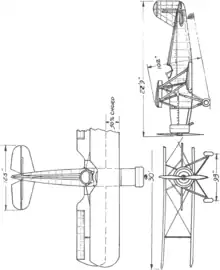Meyers OTW
The Meyers OTW (Out To Win) was a 1930s United States training biplane designed by Allen Meyers and built by his Meyers Aircraft Company from 1936 to 1944.
| Meyers OTW | |
|---|---|
.jpg.webp) | |
| Meyers OTW | |
| Role | Training biplane |
| Manufacturer | Meyers Aircraft Company |
| Designer | Allen Meyers |
| First flight | 1936 |
| Produced | 1936-1944 |
| Number built | 102 |
Development
In anticipation for a demand for training aircraft caused by the introduction of a civilian war training scheme (in which civil flying schools would provide primary training for the military), Allen Meyers designed the OTW and formed the Meyers Aircraft Company to build it. The OTW was a conventional biplane with tandem seating for two in open cockpits and a fixed tailwheel landing gear. The prototype was powered by a 125 hp (93 kW) Warner Scarab engine and it first flew on 10 May 1936. The aircraft was produced in two main variants; the OTW-145 powered by a 145 hp (108 kW) Warner Super Scarab, and the OTW-160 powered by a 160 hp (119 kW) Kinner R-5 engine.
Variants
- OTW-125
- Production variant with 125hp (93kW) Warner Scarab engine.
- OTW-145
- Production variant with 145hp (108kW) Warner Super Scarab engine.
- OTW-160
- Final production variant with 160hp (119kW) Kinner R-5 engine.
- OTW-KR
- One aircraft was re-engined with a 120hp (89kW) Ken-Royce 7G engine.
Surviving aircraft

- 1 – On static display at the Combat Air Museum in Topeka, Kansas. It was acquired by the museum in late 1986.[1]
- 2 – Airworthy with Russell W. Kilmer of Yuba City, California.[2]
- 45 – Airworthy with James Kieran Padden in Longhirst, Northumberland.[3]
- 53 – Airworthy at the Pioneer Flight Museum in Kingsbury, Texas.[4][5]
- 57 – Airworthy with Theodore K. Heckman in Allegan, Michigan.[6]
- 102 – On static display at the EAA Aviation Museum in Oshkosh, Wisconsin. It was the last OTW built and was assembled from parts to be the personal aircraft of Allen Meyers.[7]
Specifications (OTW-160)

Data from Jane's all the World's Aircraft 1947.[8]
General characteristics
- Crew: 2
- Length: 25 ft 11 in (7.91 m)
- Wingspan: 30 ft 0 in (9.14 m)
- Height: 8 ft 6 in (2.59 m)
- Wing area: 262 sq ft (24.3 m2)
- Empty weight: 1,340 lb (608 kg)
- Gross weight: 1,910 lb (866 kg)
- Fuel capacity: 26 US gal (22 imp gal; 98 L)
- Powerplant: 1 × Kinner R-56 5-cyl. air-cooled radial piston engine, 160 hp (120 kW)
- Propellers: 2-bladed fixed pitch propeller
Performance
- Maximum speed: 120 mph (190 km/h, 100 kn)
- Cruise speed: 105 mph (169 km/h, 91 kn)
- Range: 400 mi (640 km, 350 nmi)
- Service ceiling: 17,500 ft (5,300 m)
- Rate of climb: 1,200 ft/min (6.1 m/s)
- Wing loading: 7.25 lb/sq ft (35.4 kg/m2)
- Power/mass: 11.81 lb/hp (7.17 kg/kW)
- Landing speed: 40 mph (35 kn; 64 km/h)
References
- "Meyers OTW (Out To Win) Serial #1 (FAA Reg. Number N15784)". Combat Air Museum. Combat Air Museum. Retrieved 30 January 2018.
- "FAA Registry [N23799]". Federal Aviation Administration. U.S. Department of Transportation. Retrieved 2 April 2023.
- "GINFO".
- "1941 Meyers OTW". Pioneer Flight Museum. Retrieved 30 January 2018.
- "FAA REGISTRY [N34310]". Federal Aviation Administration. U.S. Department of Transportation. Retrieved 30 January 2018.
- "FAA Registry [N34313]". Federal Aviation Administration. U.S. Department of Transportation. Retrieved 25 October 2022.
- "Airframe Dossier - Meyers OTW-145, c/n 102, c/r N34357". Aerial Visuals. Aerial Visuals. Retrieved 30 January 2018.
- Bridgman, Leonard, ed. (1947). Jane's all the World's Aircraft 1947. London: Sampson Low, Marston & Co. p. 264c.
- Juptner, Joseph P. (1980). U.S. Civil Aircraft Vol. 8 (ATC 701 – ATC 800). Fallbrook, California, US: Aero Publishers Inc. ISBN 0-8168-9178-8.
Further reading
- Taylor, Michael J. H. (1989). Jane's Encyclopedia of Aviation. London: Studio Editions.
- The Illustrated Encyclopedia of Aircraft (Part Work 1982-1985). Orbis Publishing. pp. 2476–7.